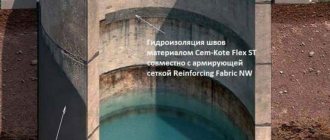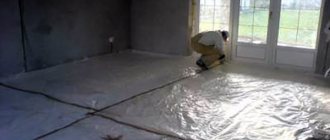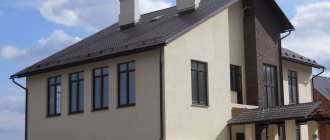It is not necessary to insulate it in all cases, and sometimes it even harms the structures of the house.
According to modern urban planning standards, in order to ensure normal temperature conditions in a house located in the central regions of the country, the thermal resistance of wall structures must exceed 3.2 m2 C/W. This indicator can be achieved by aerated concrete products D400 with a thickness of 400 mm or D500 with a thickness of 500 mm.
In this article we will talk about thermal protection options for aerated block walls, and what is best to choose to insulate a house.
The role of the correct choice of material for thermal protection
To ensure the standard thermal resistance of a wall made of aerated blocks is more than 3.2 m2 C/W, additional insulation will be required based on:
- D500(300mm) + 100mm insulation
- D500(350mm) + 50mm insulation.
If objects are located in the northern and eastern regions, then an additional increase in the thickness of the thermal insulation will be required.
When selecting heat-protective materials, it is necessary to take into account the special properties of aerated concrete, namely its high vapor permeability . This material not only retains thermal energy well, but also easily allows steam to pass through. Within its walls there are constantly 2 processes of moisture exchange: natural and forced.
The main materials for thermal protection of aerated concrete walls are mineral wool, Penoplex and heat-protective plaster. For these types of walls, it is strictly forbidden to use polystyrene foam, because it is vapor-tight and will trap water inside the wall.
For external mounting
Insulation from the outside is the most preferred and effective option for protecting aerated concrete walls.
There are quite a few options for such arrangement of thermal protection:
- “wet” lightweight design;
- “wet” heavy;
- dry installation with ventilation sheathing;
- frameless installation.
The simplest are the “wet” version with a light plaster finish. The name “wet” method was given in connection with the dilution of adhesive mixtures with water.
From inside a room made of aerated concrete
Installing a thermal protection system indoors is very rare , only when it cannot be done outside.
In this option, thermal insulation should be carried out not only on the walls, but also on the floor and ceiling. Otherwise, it will be impossible to block the penetration of cold into the room.
Characteristics of aerated concrete
According to their operational characteristics, blocks are divided into three types:
- structural;
- thermal insulation;
- mixed.
The first type is used for the construction of walls. Sometimes they are even used for arranging a shallow foundation. The density of such products reaches D900 or even D1200.
The thermal conductivity coefficient increases due to increased density. Porosity decreases and the heat retention rate becomes 0.14 W/m*°C. For such structures, insulation is mandatory.
Blocks with a thermal conductivity index of 0.096 W/m*°C are not a material for the construction of walls. They are used:
- for external insulation, in the form of masonry;
- for the installation of partitions;
- as a material for creating decorative elements of the facade.
The density grade of such blocks is from D300 to D500.
Products with average performance are used for construction of up to three floors. They have sufficient load-bearing capacity, but a high heat transfer rate. Therefore, knowing how to insulate aerated concrete, you can get a durable structure with a comfortable microclimate.
Walls made of this material have high moisture absorption. The percentage of absorption is up to 35. This negatively affects the heat and sound insulation properties.
The masonry must be isolated from sources of moisture by waterproofing. The blocks are also separated from the foundation by a waterproof layer.
The light weight of the blocks allows us to reduce the cost of the foundation. On average, one block measuring 625x100x250 weighs 8 kg. Taking into account the number of floors and the size of the building, you can set the required dimensions of the base. At the same time, the weight of insulation can be increased, achieving economic rationality.
What is suitable for insulation?
When performing thermal insulation work on aerated concrete blocks, it is unacceptable to use metal dowels and screws . The slabs are fastened with special chemical anchors and adhesives.
Because even small cracks and chips in aerated blocks can lead to the destruction of the entire wall. The installation of insulation on the outer and inner parts of the wall is different, but it is much easier to install thermal insulation inside.
For external mounting
External thermal protection of walls significantly increases the life span of the house and helps remove moisture vapor from the wall material. Since aerated concrete is characterized by increased vapor permeability , neither foam plastic nor other vapor-tight insulators can be used for these purposes.
They disrupt the vapor exchange between the room and the environment. Moisture will begin to condense at the boundary between the wall and the insulation, which will contribute to the accumulation of moisture in the gas blocks. Due to oversaturation with moisture, the blocks will begin to rot, creating mold on the walls.
The best option for thermal protection of a house made of aerated concrete is considered to be mineral wool made from inorganic fibers . This structure allows you to resist the movement of cold air currents, thereby preventing heat loss from external walls in heated rooms.
Advantages of using mineral wool in external thermal protection systems for aerated concrete walls:
- non-flammable material;
- very high vapor permeability;
- additional noise protection.
The next most popular is basalt wool , which has a similar structure to mineral wool, but it is produced not from quartz, but from rocks.
In terms of thermal conductivity, both materials are actually equal to 0.036 W/(m2*C), but in terms of fire resistance, basalt wool has a higher indicator, in addition, it does not contain polymer substances. The only thing that makes basalt wool worse than mineral wool is that it requires a frame for installation.
Another popular insulation for external gas-block walls is Penoplex. It is a modern modification of polystyrene foam, but with improved fire resistance and vapor permeability characteristics. The insulation has a thermal conductivity of 0.03 W/(m2*C).
From inside the room
Penoplex can also be installed indoors on special frames with a finishing coating with facing material. It is also allowed to install basalt wool indoors.
Recently, a new technology for internal thermal protection of walls using warm plaster has been gaining popularity. This is an ordinary dry plaster mixture, to which insulation is added in the form of crumbs and other fillers. It is applied to the wall. Such compositions have a low flammability rate, have good vapor permeability and high thermal protection.
Do I need to insulate the walls?
To figure out whether it’s worth insulating your home, you need to highlight several factors:
- Take into account the climate zone of your residence;
- Determine the density and thickness of the blocks;
- Determine the thickness of the seams between the blocks.
I can say that the best option is to think about insulation at the stage of wall construction. This is explained by the fact that laying blocks on cement and thick seams (they are called “cold zones”) can lead to heat leaving the house. To prevent this from happening, the blocks must be laid on special glue, and the seams should be made no more than 3 mm.
If the thickness of the blocks themselves exceeds 375 mm, then only cladding can be done. In this case, two conditions must be met: the blocks are not too dense, and the seams are made perfectly.
Your home needs insulation if:
- High-density aerated concrete (more than D500) was used during construction;
- low-density aerated concrete (below 300mm) was used during construction;
- during construction, the supporting frames were filled with aerated concrete blocks;
- very thick seams are used;
- When laying the blocks, not glue was used, but cement mortar.
All these factors together make it clear that it is necessary to think about thermal insulation so that there is no cold and discomfort in winter.
Related article: How to decoupage a coffee table with your own hands?
What is the best means of protection against the cold?
Considering the practice of thermal protection of aerated concrete houses, experts consider mineral wool and Penoplex to be the best materials. Both insulation materials are universal materials and can be used both inside and outside a load-bearing wall.
In order to choose the best of them, you need to analyze the characteristics of mineral wool (MV) and Penoplex (PP):
in terms of fire resistance, MV has the best performance;- In terms of moisture resistance, PP comes first;
- resistance to mechanical damage - MV;
- environmental safety - MV;
- thermal insulation: MV - 0.036 W/(m2*C), PP - 0.03 W/(m2*C);
- durability - PP;
- cost - PP;
- sound insulation - MV.
How to choose the thickness of insulation?
The thickness of the insulation depends on the climate in which the owner of the house lives. But still, you should not use slabs from two to four centimeters, since they are not particularly useful. The thicker the insulation layer on the walls, the less you will have to spend on heating in the future. In addition, by choosing thinner insulation, you will not save much.
A thinner layer will not contribute to better insulation, and is acceptable only for interior decoration. Then it is better not to take up the area of the room with a bulky ten-centimeter layer.
Installation cost and price of materials per m2
The total cost of thermal insulation work consists of the cost of insulation and consumables, wages of hired workers and transportation costs.
The cost of work depends on the following indicators:
- type of insulation: mini-ply or Penoplex;
- type of installation: external or internal, frame or frameless, “wet” or with a ventilation system;
- geometric complexity of wall structures;
- transport interchange, type of transport necessary for transportation and loading and unloading;
- the need to rent equipment;
- the permissibility of storing building materials in the local area; if the process of building walls is delayed, then it is better to store the material indoors, protected from moisture;
- the need to use scaffolding if the house is multi-story;
- level of qualification of performers.
The approximate cost of paying for the work and hired personnel costs the developer in Moscow and the Moscow region 2,400 rubles/m2; in the periphery these prices are 15-25% lower.
Average cost of materials for insulating aerated concrete houses by region of the Russian Federation:
| Name | Dimension | Average prices |
| Basalt wool | ||
| TechnoNIKOL | RUR/m2 | 180 |
| Paroc | RUR/m2 | 210 |
| Rockwool | RUR/m2 | 110 |
| Baswool | RUR/m2 | 165 |
| Minvata | ||
| Ursa Geo | RUR/m2 | 150 |
| Rocklight | RUR/m2 | 89 |
| Knauf | RUR/m2 | 165 |
| Isoroc | RUR/m2 | 200 |
| Penoplex | ||
| 100 mm | RUR/m2 | 480 |
| 50 mm | RUR/m2 | 260 |
| 30 mm | RUR/m2 | 220 |
Two common methods of external thermal insulation
Builders most often offer one of two insulation methods: a plaster system, also called the “wet method,” and a ventilated facade, also known as a dry insulation method.
Wet facade
The plaster insulation system looks like this:
- outer wall;
- insulation;
- adhesive mixture with embedded reinforcing alkali-resistant plastic mesh;
- facade finishing.
The method is good for independent implementation, since it does not require the construction of a frame and high qualifications of the performer, however, such insulation can only be carried out at positive air temperatures.
Ventilated facade
A ventilated façade is considered more reliable among professionals and provides more opportunities for home decoration. The insulation scheme looks like this:
- outer wall;
- supporting frame;
- insulation;
- wind and moisture protective membrane;
- ventilated gap of at least 40 mm;
- curtain façade.
To perform thermal insulation using this method, it will be necessary to build a frame with precise alignment of the facade surface, otherwise unevenness will be visible on the facade.
A ventilated façade provides more opportunities for exterior finishing; work can be performed at temperatures as low as minus 7°C, but the contractor must have skills in using construction tools.
How to insulate a house with your own hands using polyurethane foam?
3 instructions for action to choose from:
- Curtain façade. A special wooden or metal frame structure is created, the pitch of which is equal to the width of the thermal insulation material. Polyurethane foam is placed in the cells of the frame, and a decorative layer is mounted on top.
- Wet facade. The surface of the gas block is cleaned. Polyurethane foam is attached with glue and secured with dowels. After this, the wall is plastered in 2 layers using a reinforcing mesh.
- Wet façade with reinforcement. If you choose brick or natural stone, then you need to use hooks to fix the insulation. Then reinforce the surface with mesh and plaster. As soon as the plaster dries, the cladding is done. Thanks to this option, there is no need to strengthen the walls and foundation. This is the most preferred method in construction.
Surface preparation
The surface of aerated blocks requires some preparation before proceeding with the installation of foam. Due to the fact that the blocks are made in molds and then cut, one of the surfaces can be quite smooth, so for better adhesion it must be made rough. To do this, you can use coarse sandpaper, which you just need to walk over the surface. Due to its porosity, aerated concrete can quickly absorb moisture from the glue, which will create difficulties during insulation. Therefore, in some cases it will be appropriate to treat the walls with a primer. Since the primer is absorbed quite quickly, several layers of the material can be applied. Each one is laid after the previous one has dried. It is more convenient to use a roller with a long handle for these purposes.
Expanded polystyrene
Extruded polystyrene foam (EPS) is one of the types of foam plastic. Expanded polystyrene is produced by foaming the starting ingredients at high temperature and pressure. The production method determines the physical properties of the material - it is mechanically strong, frost-resistant and can have different densities. The higher the density (and strength) of EPS, the higher the thermal conductivity. Vapor and air permeability are always at the same (low) level, and water absorption is minimal. The combination of qualities makes it possible to widely use EPS as an insulating facade material.
An undesirable property of polystyrene foam for aerated concrete walls - low vapor permeability, leading to the appearance of a thermos effect and a shift in the dew point - is avoided by installing a ventilation gap. As in the case of using polystyrene foam, the second option is possible - installing powerful supply and exhaust ventilation. Installation of the insulating layer and decorative finishing is carried out according to the same scheme as for foam plastic.
Expanded polystyrene boards
Service life and other advantages of insulation
The service life of mineral wool thermal insulation ranges from 25 to 40 years. Other advantages of this insulation include:
- environmental friendliness is not relevant in this case, because the insulation is located outside and inside the “pie” of the wall;
- non-flammable , the material does not support combustion;
- no smoke formation under the influence of open fire;
- low hydrophobicity, does not absorb moisture, but lets it out;
- low deformation, the insulation does not lose its shape over time;
- biological and chemical stability, inertness.
The characteristics and quality of mineral wool largely depend on the manufacturer. Mineral wool " TechnoNIKOL ", "Rockwool", "Parok", "Ursa" is considered good











